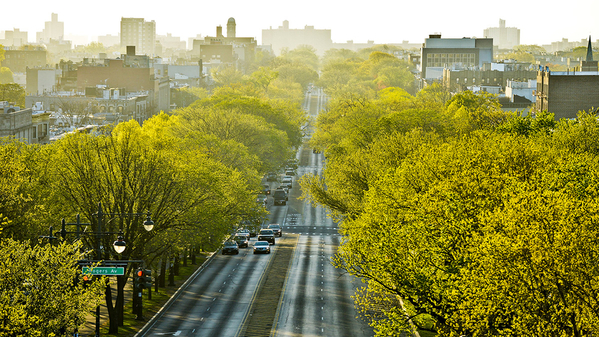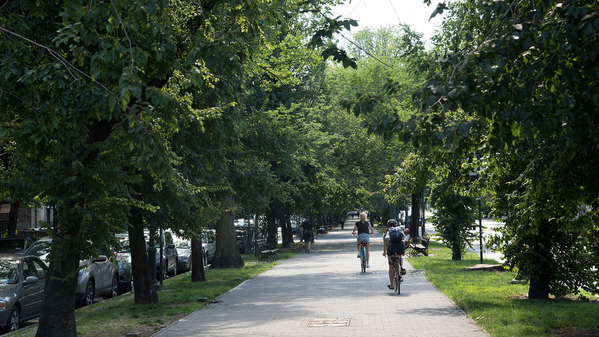Where Gumbo Was #358
Sometimes a grand idea works out as expected; sometimes it doesn't. And sometimes, the underlying idea is so strong that the missing details don't matter. Brooklyn's Eastern Parkway, the world's first parkway, is a case in point.
Frederick Law Olmsted and Calvert Vaux, the star park and landscape planners and builders of the 19th century, envisioned two grand boulevards, themselves parklike, connecting their Brooklyn masterpiece, Prospect Park to the edges of the then-independent City of Brooklyn.
Eastern Parkway was to be the grander of the two, running from the park to the city line; Ocean Parkway led off in another direction, connecting the park at the center of Brooklyn to resorts at Coney Island at the southern edge. Both were built, both are successful and beautiful city landmarks, with broad roadways, walkways and tree-lined malls, but those unifying details only partly mask the motley range of development and communities along the way.
Near its eastern end, Eastern Parkway borders Lincoln Terrace Park
Olmsted and Vaux thought Eastern Parkway would be lined with stately mansions and large and stately apartment buildings, and there are certainly some of those, but over the years after the parkway was first laid out, development took place in stages and economics rather than aesthetics often made the decisions.
After the original Parkway ends at the former city limit, the malls disappear and only a skimpy median marks it as anything but an ordinary avenue.
Even though, as you can see in my set of winter pictures, there is neither uniformity nor grandeur along the route, summer pictures soften the impression and show the kind of green intention that made this the world's first parkway, a traffic route combined with a park, and free of commercial traffic, at least in the beginning.


Summer pictures: NYC Parks Dept and WTTW Chicago
Olmsted described the intention as "a shaded green ribbon" which might "be absolutely formal or strikingly picturesque, according to circumstances." In the end, the circumstances were more varied than he expected or wanted.
During the Duvalier years, the second-floor office of lawyer Wilson Desir was the heart of mutual assistance and resistance.
But even the wide range of styles and circumstances, while missing the planners' mark, make for an interesting drive through central Brooklyn, through areas that have been at the heart of Brooklyn's Haitian and Caribbean populations, past the blocks and buildings that are the world center of Chabad Lubavitch, one of the largest groups of Hasidic Jews, and in front of the grand facades of the Brooklyn Museum and Central Library.
770 Eastern Parkway, above, and its neighbor have been the headquarters of the Lubavitcher Hasidic movement since the 1940s.
It also made for an eclectic group of clues, some quickly recognized by PortMoresby and George G; George G also recognized the overall answer to Where in the World is TravelGumbo: Eastern Parkway, Brooklyn, New York.
At its western end, starting from the park's Grand Army Plaza, Eastern Parkway passes the Brooklyn Museum, which faces some of the more impressive apartment houses on the avenue.
Further along, other kinds of apartments appear, built at different periods. They include a number of four-story walk-ups, less desirable these days, but nicely done for their time. The elevator buildings of the 20s and 30s, a prime building time on the Parkway, have seen rising prices in recent years.
Even some of the smaller buildings have interesting decorative touches. The mason who did this facade could claim to have invented Op Art.
And the past few years have seen some new construction, not all of it elegant.
There are also blocks of typical Brooklyn brownstones along the Parkway, but some of them have been 'transmogrified,' or, some might say, "remuddled." Some of the odd additions and modifications have included paving over front yards to create parking spaces, some of them only dubiously legal.
And there are some more stately mini-mansions along the way, though a few of them have punishingly steep front steps!
Brooklyn is known as the Borough of Churches, and Eastern Parkway has its share of religious institutions, including quite a few yeshivas and other buildings used by the Lubavitchers.
There are quite a few sizable churches along Eastern Parkway, several showing signs of previous purpose as theaters (that's a popular New York tradition: over fifty theaters are serving as churches in the city). The Kameo, whose facade decor was this puzzle's first clue, is undergoing repair; it's the long-time home of the Philadelphian Sabbath Cathedral. Not far away, First Baptist draws a sizable crowd.
A church and its rectory just off Utica Avenue leave a quieter impression than their neighhbor, a former bank turned sporting goods store.
A handsome New York City public school and a branch of the Brooklyn Public Library are only a few of the public buildings along the way.
And a lively market that has developed at the Utica Avenue subway station.
All in all, then, Eastern Parkway has ended up looking quite different from the original vision—and yet the physical outline brings the details into a kind of harmony, with the malls and trees, and generous proportions making it into something different from 'just another big street.'



Comments (0)